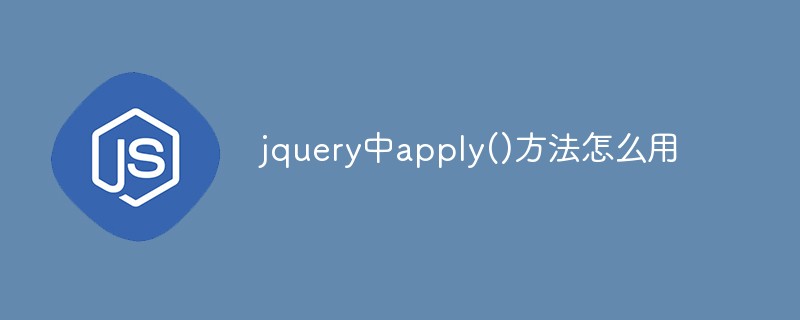jQuery’s array processing is convenient and fully functional. It encapsulates many functions that native JavaScript array cannot achieve in one step. The following is a detailed explanation of the use of jquery arrays. Friends who need it can refer to
1. $.each(array, [callback]) traversal [commonly used]
Explanation: Different from traversing jQuery objects The $().each() method can be used to iterate over any object. Callback function has two parameters: the first is the member of the object or the index of the array, and the second is the corresponding variable or content. If you need to exit the each loop, you can make the callback function return false, and other return values will be be ignored.
Each traversal is familiar to everyone. In ordinary event processing, it is a variant of the for loop, but it is more powerful than the for loop. In an array, it can easily capture the array index and corresponding value. Example:
The code is as follows:
var _mozi=['墨家','墨子','墨翟','兼爱非攻','尚同尚贤']; //本文所用到的数组, 下同
$.each(_mozi,function(key,val){
//回调函数有两个参数,第一个是元素索引,第二个为当前值
alert('_mozi数组中 ,索引 : '+key+' 对应的值为: '+val);
});Compared with the native for..in, each is stronger. for..in can also traverse the array and return the corresponding index, but the value needs to be obtained through arrName[key].
2. $.grep(array, callback, [invert]) filter array [commonly used]
Explanation: Use the filter function to filter array elements. This function passes at least two parameters (the third Each parameter is true or false, and the return value of the filter function is inverted. I personally think it is not very useful): the array to be filtered and the filter function. The filter function must return true to retain the elements or false to delete the elements. In addition, the filter function can also be Can be set to a text string.
The code is as follows:
$.grep(_mozi,function(val,key){
//过滤函数有两个参数,第一个为当前元素,第二个为元素索引
if(val=='墨子'){
alert('数组值为 墨子 的下标是: '+key);
}
});
var _moziGt1=$.grep(_mozi,function(val,key){
return key>1;
});
alert('_mozi数组中索引值大于1的元素为: '+_moziGt1);
var _moziLt1=$.grep(_mozi,function(val,key){
return key>1;
},true);
//此处传入了第三个可靠参数,对过滤函数中的返回值取反
alert('_mozi数组中索引值小于等于1的元素为: '+_moziLt1);3. $.map(array,[callback])Convert array according to given conditions [General]
Explanation: The conversion function as a parameter will be called for each array element, and the conversion function will be passed an element representing the converted element as a parameter. The conversion function can return the converted value, null (delete the item in the array) or an array containing values, expanded into the original array.
This is a very powerful method, but it is not commonly used. It can update the value of an array element based on specific conditions, or expand a new copy element based on the original value.
The code is as follows:
var _mapArrA=$.map(_mozi,function(val){
return val+'[新加]';
});
var _mapArrB=$.map(_mozi,function(val){
return val=='墨子' ? '[只给墨子加]'+val : val;
});
var _mapArrC=$.map(_mozi,function(val){
//为数组元素扩展一个新元素
return [val,(val+'[扩展]')];
});
alert('在每个元素后面加\'[新加]\'字符后的数组为: '+ _mapArrA);
alert('只给元素 墨子 添加字符后的数组为: '+ _mapArrB);
alert('为原数组中每个元素,扩展一个添加字符\'[新加]\'的元素,返回的数组为 '+_mapArrC);4 .$.inArray(val,array) determines whether the value exists in the array [commonly used]
Explanation: Determine the position of the first parameter in the array, counting from 0 (returns -1 if not found).
Remember the indexOf() method? indexOf() returns the first occurrence of the string, while $.inArray() returns the position of the incoming parameter in the array. Similarly, if found, What is returned is a value greater than or equal to 0, or -1 if not found. Now, you know how to use it. With it, it becomes easy to determine whether a value exists in the array.
The code is as follows:
var _exist=$.inArray('墨子',_mozi);
var _inexistence=$.inArray('卫鞅',_mozi)
if(_exist>=0){
alert('墨子 存在于数组_mozi中,其在数组中索引值是: '+_exist);
}
if(_inexistence<0){
alert('卫鞅 不存在于数组_mozi中!,返回值为: '+_inexistence+'!');
}5 .$.merge(first,second) merges two arrays [general]
Explanation: Returned results will modify the contents of the first array - the elements of the first array are followed by the elements of the second array. This method uses jQuery's method to replace the native concat() method, but its function is not as powerful as concat(), which can merge multiple arrays at the same time.
The code is as follows:
//原生concat()可能比它还简洁点 _moziNew=$.merge(_mozi,['鬼谷子','商鞅','孙膑','庞涓','苏秦','张仪']) alert('合并后新数组长度为: '+_moziNew.length+'. 其值为: '+_moziNew);
6 .$.unique(array) filters duplicate elements in the array [not commonly used]
Explanation: Delete duplicate elements in the array. Only deletes are processed An array of DOM elements, but cannot handle string or numeric arrays.
The first time I saw this method, I thought it was a very convenient method that can filter duplicates. How perfect. But if you take a closer look, you can see that it can only handle DOM elements, and its functionality is 20% off. Therefore, I defined it as an element that is not commonly used. At least, I have not used it since I started using jQuery.
The code is as follows:
var _h2Arr=$.makeArray(h2obj);
//将数组_h2Arr重复一次
_h2Arr=$.merge(_h2Arr,_h2Arr);
var _curLen=_h2Arr.length;
_h2Arr=$.unique(_h2Arr);
var _newLen=_h2Arr.length;
alert('数组_h2Arr原长度值为: '+_curLen+' ,过滤后为: '+_newLen
+' .共过滤 '+(_curLen-_newLen)+'个重复元素')7. $.makeArray(obj) Convert array-like objects into arrays [not commonly used]
Explanation: Convert an array-like object into an array object. The array-like object has a length attribute, and its member indexes range from 0 to length-1.
This is a redundant method. The omnipotent $ originally includes this function. The explanation on the jQuery official website is very vague. In fact, it converts an array-like object (such as a collection of element objects obtained with getElementsByTagName) into an array object.
The code is as follows:
var _makeArr=$.makeArray(h2obj); alert('h2元素对象集合的数据 类型转换 为: '+_makeArr.constructor.name);//输出Array
8. $(dom).toArray() restores all DOM elements into arrays [not commonly used]
Explanation : Restore all DOM elements in the jQuery collection into an array. It is not a commonly used method. I personally think it is as redundant as $.makeArray.
The code is as follows:
var _toArr=$('h2').toArray(); alert('h2元素集合恢复后的 数据类型 是: '+_toArr.constructor.name);
The above is the detailed content of The use of jquery-based arrays. For more information, please follow other related articles on the PHP Chinese website!
 jquery实现多少秒后隐藏图片Apr 20, 2022 pm 05:33 PM
jquery实现多少秒后隐藏图片Apr 20, 2022 pm 05:33 PM实现方法:1、用“$("img").delay(毫秒数).fadeOut()”语句,delay()设置延迟秒数;2、用“setTimeout(function(){ $("img").hide(); },毫秒值);”语句,通过定时器来延迟。
 axios与jquery的区别是什么Apr 20, 2022 pm 06:18 PM
axios与jquery的区别是什么Apr 20, 2022 pm 06:18 PM区别:1、axios是一个异步请求框架,用于封装底层的XMLHttpRequest,而jquery是一个JavaScript库,只是顺便封装了dom操作;2、axios是基于承诺对象的,可以用承诺对象中的方法,而jquery不基于承诺对象。
 jquery怎么修改min-height样式Apr 20, 2022 pm 12:19 PM
jquery怎么修改min-height样式Apr 20, 2022 pm 12:19 PM修改方法:1、用css()设置新样式,语法“$(元素).css("min-height","新值")”;2、用attr(),通过设置style属性来添加新样式,语法“$(元素).attr("style","min-height:新值")”。
 jquery怎么在body中增加元素Apr 22, 2022 am 11:13 AM
jquery怎么在body中增加元素Apr 22, 2022 am 11:13 AM增加元素的方法:1、用append(),语法“$("body").append(新元素)”,可向body内部的末尾处增加元素;2、用prepend(),语法“$("body").prepend(新元素)”,可向body内部的开始处增加元素。
 jquery怎么删除div内所有子元素Apr 21, 2022 pm 07:08 PM
jquery怎么删除div内所有子元素Apr 21, 2022 pm 07:08 PM删除方法:1、用empty(),语法“$("div").empty();”,可删除所有子节点和内容;2、用children()和remove(),语法“$("div").children().remove();”,只删除子元素,不删除内容。
 jquery中apply()方法怎么用Apr 24, 2022 pm 05:35 PM
jquery中apply()方法怎么用Apr 24, 2022 pm 05:35 PM在jquery中,apply()方法用于改变this指向,使用另一个对象替换当前对象,是应用某一对象的一个方法,语法为“apply(thisobj,[argarray])”;参数argarray表示的是以数组的形式进行传递。
 jquery怎么去掉只读属性Apr 20, 2022 pm 07:55 PM
jquery怎么去掉只读属性Apr 20, 2022 pm 07:55 PM去掉方法:1、用“$(selector).removeAttr("readonly")”语句删除readonly属性;2、用“$(selector).attr("readonly",false)”将readonly属性的值设置为false。
 jquery on()有几个参数Apr 21, 2022 am 11:29 AM
jquery on()有几个参数Apr 21, 2022 am 11:29 AMon()方法有4个参数:1、第一个参数不可省略,规定要从被选元素添加的一个或多个事件或命名空间;2、第二个参数可省略,规定元素的事件处理程序;3、第三个参数可省略,规定传递到函数的额外数据;4、第四个参数可省略,规定当事件发生时运行的函数。


Hot AI Tools

Undresser.AI Undress
AI-powered app for creating realistic nude photos

AI Clothes Remover
Online AI tool for removing clothes from photos.

Undress AI Tool
Undress images for free

Clothoff.io
AI clothes remover

AI Hentai Generator
Generate AI Hentai for free.

Hot Article

Hot Tools

ZendStudio 13.5.1 Mac
Powerful PHP integrated development environment

mPDF
mPDF is a PHP library that can generate PDF files from UTF-8 encoded HTML. The original author, Ian Back, wrote mPDF to output PDF files "on the fly" from his website and handle different languages. It is slower than original scripts like HTML2FPDF and produces larger files when using Unicode fonts, but supports CSS styles etc. and has a lot of enhancements. Supports almost all languages, including RTL (Arabic and Hebrew) and CJK (Chinese, Japanese and Korean). Supports nested block-level elements (such as P, DIV),

SecLists
SecLists is the ultimate security tester's companion. It is a collection of various types of lists that are frequently used during security assessments, all in one place. SecLists helps make security testing more efficient and productive by conveniently providing all the lists a security tester might need. List types include usernames, passwords, URLs, fuzzing payloads, sensitive data patterns, web shells, and more. The tester can simply pull this repository onto a new test machine and he will have access to every type of list he needs.

WebStorm Mac version
Useful JavaScript development tools

DVWA
Damn Vulnerable Web App (DVWA) is a PHP/MySQL web application that is very vulnerable. Its main goals are to be an aid for security professionals to test their skills and tools in a legal environment, to help web developers better understand the process of securing web applications, and to help teachers/students teach/learn in a classroom environment Web application security. The goal of DVWA is to practice some of the most common web vulnerabilities through a simple and straightforward interface, with varying degrees of difficulty. Please note that this software






